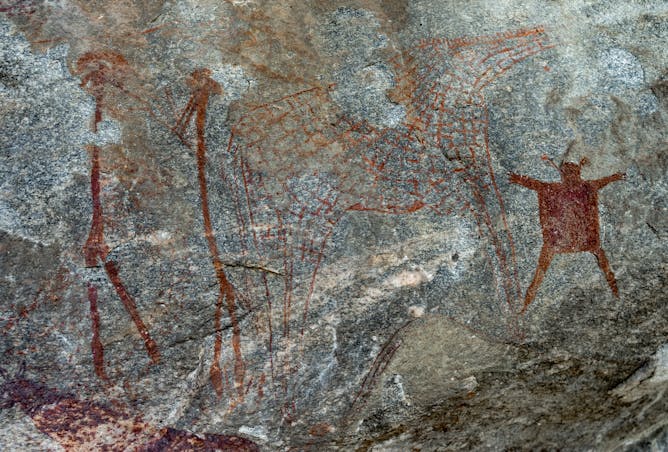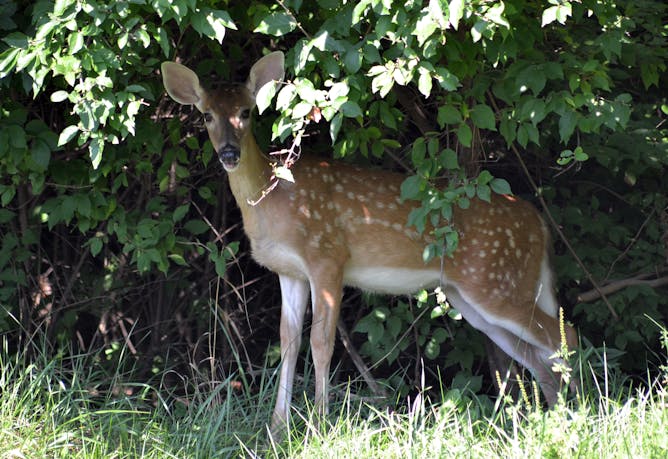|
|
|
|
A study published today offers fascinating insights into how people lived in Africa around 50,000 years ago using a relatively new technique in anthropology: ancient DNA analysis. By combining DNA garnered from archaeological human remains with other sources, including linguistics and oral and written histories, the team was able to discern how widely African peoples moved and intermingled in a period known as the Later Stone Age.
One of the more shocking pieces of news to me about the coronavirus from the past year was the discovery that infection of white-tailed deer in the U.S. is widespread. More than a dozen captive and wild species have been infected. Three veterinary researchers from Colorado State University provide an overview of the science on this subject of animal virology and explain why it matters to both animal and human health.
A great thing about working with academics is hearing about some of the solutions to big problems that they’re crafting. Engineering professor Roger Bales reports on a solar canal project slated to be tested in California’s Central Valley, in which Bales’ research team is participating. As you can see from the artist’s rendition below, solar panels will cover a portion of California’s extensive water canals, providing electricity and reducing evaporation.
Also in this week’s science and research news:
If there’s a subject you’d like our team of science editors to investigate, please reply to this email.
|

|
Martin La Monica
Director of Editorial Projects and Newsletters
|
|

Together with artifacts from the past, ancient DNA can fill in details about our ancient ancestors.
Nina R/Wikimedia Commons
Elizabeth Sawchuk, University of Alberta; Jessica Thompson, Yale University; Mary Prendergast, Rice University
A new study doubles the age of ancient DNA in sub-Saharan Africa, revealing how people moved, mingled and had children together over the last 50,000 years.
|

White-tailed deer are one of the few wild species that scientists have found to be infected with the coronavirus – at least so far.
Andrew C/WikimediaCommons
Sue VandeWoude, Colorado State University; Angela Bosco-Lauth, Colorado State University; Christie Mayo, Colorado State University
Scientists have been testing captive and wild animals for the coronavirus since the pandemic began. Only a few wild species are known to carry the virus, but many more have been shown to be susceptible.
|

An artist’s rendering of a solar canal.
Robin Raj, Citizen Group & Solar Aquagrid
Roger Bales, University of California, Merced
Covering the state’s canals with solar panels would reduce evaporation of precious water and help meet renewable energy goals – all while saving money.
|
|
|
-
Sagar Samtani, Indiana University
Artificial intelligence is emerging as a key cybersecurity tool for both attackers and defenders.
-
Mai Vu, Tufts University
As the wireless telecommunications companies ramp up their 5G rollouts, they are beginning to pull the plug on their 3G networks. 2022 is the end of the line for the venerable cellphone service.
-
Steven R. Fassnacht, Colorado State University; Sunshine Swetnam, Colorado State University
Innovation made the 2022 Winter Games possible in Beijing, but snowmaking has limits in a warming climate.
-
Ann Elsner, Indiana University
Whether at a family gathering or in a research lab, getting access to images immediately was a game-changer. And Land’s innovations went far beyond the instant photo.
-
John F. Tooker, Penn State
Studies suggest that seeds coated with neonicotinoid insecticides may harm nontarget insects, mammals and birds. In response, states are starting to restrict use of these products.
-
Sylvia G. Dee, Rice University
His theory, based on years of detailed climate and weather data, became known as the Callendar Effect. Today we call it global warming.
-
Matthew E. Kahn, USC Dornsife College of Letters, Arts and Sciences
Human behaviors shift. Policies change. New technology arrives and evolves. All those changes and more are hard to predict, and they affect tomorrow’s costs.
|
|
|
Like this newsletter? You might be interested in our other weekly emails: Enjoy reading
The Conversation? Share us with your three closest friends:
|
| |
| |
| |
| |
|
|
|
|
|
|
|